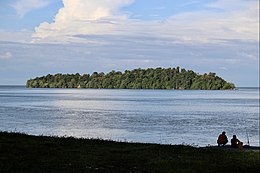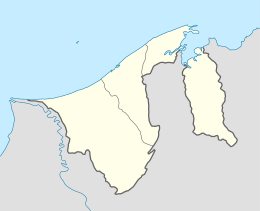| Native name: Pulau Chermin | |
|---|---|
 The island in 2022 The island in 2022 | |
 | |
| Geography | |
| Location | Brunei Bay |
| Coordinates | 4°55′47″N 115°01′30″E / 4.9298333°N 115.0249126°E / 4.9298333; 115.0249126 |
| Archipelago | Malay Archipelago |
| Area | 5 ha (12 acres) |
| Highest elevation | 110 ft (34 m) |
| Administration | |
| Brunei | |
| District | Brunei–Muara |
| Mukim | Kota Batu |
| Demographics | |
| Population | 0 |
Chermin Island (Malay: Pulau Chermin) is an islet at the mouth of Brunei River in the Mukim Kota Batu, Brunei–Muara District, Brunei. Historically, it played a crucial role in Brunei's defence strategy, particularly after the devastating raids during the Castilian War in the late 16th century. The island was fortified as a bastion to protect the capital and surrounding areas from further invasions, strategically positioned near the narrow channel upstream from the former capital. During a period of political and military instability, Chermin Island's significance was further underscored, serving as a key defensive point. It was later temporarily occupied by Sultan Abdul Hakkul Mubin as his palace following the assassination of Sultan Muhammad Ali, an event that sparked the Brunei civil war.
Geography
Chermin Island, located at the mouth of the Brunei River, spans 5 hectares (12 acres) and lies within the secondary bay southwest of Brunei Bay. Historically, it was a fortified location with defences dating back to the late 17th century, guarding the passage to the river alongside Kaingaran Island [id], situated approximately half a mile to the north. The bay's rugged escarpments and natural defensive features highlight its strategic significance.
Navigation around the island is aided by a red-and-white beacon positioned about 0.5 miles (0.80 km) northeast. The island's geographical features, complemented by strategically placed beacons and navigational channels, are vital for guiding vessels through the intricate waterways leading to the Brunei River. Due to its proximity to Brunei Town, Chermin Island is occasionally mistaken for part of the capital. The island, which rises to 110 feet (34 m), is densely forested and characterised by steep terrain, dense jungle, and an abundance of crocodiles and snakes, making landing particularly difficult. Its northern extremity is marked by a prominent rock, with Chermin Rock, less than a fathom deep, situated nearby.
The island's vegetation includes nipa trees on the eastern side, linked to a mangrove area with species such as Avicennia, Rhizophora, and Sonneratia. In 1990, the Universiti Brunei Darussalam (UBD) Biology Department recorded seagrass Enhalus here. The rest of the island features primary forest growth, with limited sandy beaches and mostly muddy shores. Significant erosion is evident on the western side of the island. Although currently abandoned, Chermin Island is occasionally used as a leisure spot by serious sports fishermen.
History
Ong Sum Ping moved to Brunei with his people and created Kota Batu, the sultans' palace, and built a stone bar at Chermin Island, strengthening the area's defensive qualities. Sultan Muhammad Hasan established his palace and tomb at Tanjong Kindana, at the entrance of the Brunei River. He fortified Chermin Island and constructed a bridge connecting his palace at Tanjong Kindana to the fort. Using cannons created during Sultan Shah Brunei's and his own rule, this was firmly enforced. Pengiran Kesuma Negara Pengiran Hashim states that 40 boats loaded with stones were sunk in order to begin building the stone fort between Chermin Island and Keingaran Island.
The administrative seat of Brunei was relocated from Kota Batu to Chermin Island, which is situated at the mouth of Brunei River, during the civil war (1661–1673) between Sultans Muhiyddin and Abdul Hakkul Mubin. A palace and several houses were proposed on the island by the Pengiran Bendahara and later ordered by the Pehin Orang Kaya Digadong Seri Nara. Mubin then relocated the administrative capital from Kota Batu to the island during his reign, while the Pengiran Bendahara did not. It was intended for Mubin to wait out the crisis taking place prior to the Brunei civil war, the relocation was under the guidance of the newly appointed Pengiran Bongsu (later Muhyiddin). After relocation to the island, Muhyiddin declared himself as the 14th Sultan of Brunei with his authority around Kampong Ayer thus sparking the only civil war in the country.
Mubin fought the war from Chermin Island, which he had fortified to protect himself. After breaking a treaty, Mubin ultimately made his way back to Chermin Island. With the aid of a troop from the sultan of Sulu, forces from Muhyiddin landed on the island, no fighting has taken place as most fortifications were destroyed by bombardment from Tanjong Kindana. The island's fort was taken, and Mubin was put to death. Mubin has sent most of the regalia into the Brunei Bay with cannons. It is claimed that he was buried on the island.
Sultan Muhammad Alam's death in 1828, marking the end of another civil war, is closely linked to Chermin Island, where he was allegedly assassinated by hired killers. However, historian Jamil Al-Sufri questions this account due to a lack of evidence. An alternative version suggests he voluntarily left Brunei and moved to Putatan in Sabah, where a gravestone is believed to mark his burial. While there is no proof he was buried on Chermin Island, the gravestone closely resembles other royal tombstones in Brunei.
The mouth of the Brunei River, between Chermin Island and Muara, was thoroughly surveyed in 1926 by a team from HMS Herald (1923). On the evening of 27 December 1958, while traveling downstream from Brunei Town with a pilot on board, the SS Juno struck the turning light beacon off Chermin Island, causing the structure to collapse. In 1992, the island was studied by the UBD Biology Department, which recommended its preservation for its rich sediment, wildlife, and plant life. Additionally, the island has potential as an archaeological site for tourists if the historically significant fortifications once standing there are rebuilt. As of 2000, Chermin Island has been gazetted under the Antiquities and Treasure Trove Act.
Legacy
- The island has been depicted on the reverse side of the B$100 note since 2004.
See also
Notes
- Literally translates to "Mirror Island" in English.
References
Citations
- Bala 2005, p. 115.
- Leake 1989, p. 175.
- Vienne 2015, p. 59–60.
- Brunei Tourism 2019.
- ^ Silvestre et al. 1992, p. 148.
- ^ Vienne 2015, p. 6.
- ^ USNHO 1949, p. 360–363.
- Pengiran Mohammad 2007, p. 97.
- HMSO 1964, p. 158.
- Low 1880, p. 8.
- HMSO 1964, p. 160–161.
- JMMB 2012, p. 41.
- Mohd. Jamil Al-Sufri 2002, p. 18.
- ^ Ooi & King 2023.
- ^ Haji Sulaiman 2009, p. 18.
- Rozan Yunos 2008.
- Low 1880, p. 28.
- Muhammad 1966, p. 55.
- HMSO 1964, p. 163.
- Saunders 2002, p. 72.
- Vienne 2015, p. 65.
- HMSO 1968, p. 268.
- Asbol & Zaidul 2016, p. 13–14.
- Pretty 1928, p. 8.
- HMSO 1959, p. 173.
- Silvestre et al. 1992, p. 152.
- Galt, Sigaty & Vinton 2000, p. 58.
- BWE.
Sources
- "Brunei 100 Ringgit Banknote, 2004, P-29a, Polymer". www.banknoteworld.org. Banknote World Educational. Retrieved 6 January 2025.
- Ooi, Keat Gin; King, Victor T. (2023). Routledge Handbook of Contemporary Brunei. Abingdon: Routledge. doi:10.4324/9781003020431. ISBN 978-1-000-56864-6.
- "Brunei River Heritage Trail" (PDF). bruneitourism.com. Brunei Tourism. 2019. Retrieved 31 December 2024.
- Asbol Mail; Zaidul Anwar (2016). "Sultan Muhammad Alam @ Raja Api (1826–1828): Roles and Civil War An Early Analysis". Jurnal Darussalam. 16. Bandar Seri Begawan: Brunei History Centre.
- Vienne, Marie-Sybille de (2015). Brunei: From the Age of Commerce to the 21st Century. Translated by Emilia Lanier. Singapore: NUS Press. ISBN 978-9971-69-818-8.
- Bedil: Khazanah Ristaan Brunei Silam. Bandar Seri Begawan: Jabatan Muzium-Muzium Brunei. 2012.
- Haji Sulaiman Haji Duraman (2009). Kenali Negara Kita (in Malay). Bandar Seri Begawan: Dewan Bahasa dan Pustaka Brunei. ISBN 978-99917-0-638-2.
- Rozan Yunos (24 August 2008). "Civil war wrecks chaos in the country". www.bt.com.bn. The Brunei Times. Archived from the original on 14 June 2012. Retrieved 20 January 2012.
- Pengiran Dato Seri Setia Dr Haji Mohammad bin Pengiran Haji Abdul Rahman (2007). Islam di Brunei Darussalam Zaman British (1774-1984) (in Malay). Bandar Seri Begawan: Dewan Bahasa dan Pustaka Brunei. ISBN 978-99917-0-557-6.
- Bala, Bilcher (2005). Thalassocracy: A History of the Medieval Sultanate of Brunei Darussalam. Kota Kinabalu: School of Social Sciences. ISBN 978-983-2643-74-6.
- Rivers, P. J. (2004). "The Origin of 'Sabah' and a Reappraisal of Overbeck as Maharajah". Journal of the Malaysian Branch of the Royal Asiatic Society. 77 (1 (286)). Malaysian Branch of the Royal Asiatic Society: 67–99. ISSN 0126-7353. JSTOR 41493515.
- Pehin Jawatan Dalam Seri Maharaja Dato Seri Utama Dr. Haji Awang Mohd. Jamil Al-Sufri (2002). Survival of Brunei: A Historical Perspective. Bandar Seri Begawan: Brunei History Centre. ISBN 978-99917-34-18-7.
- Saunders, Graham (2002). A History of Brunei (2nd ed.). Abingdon: RoutledgeCurzon. ISBN 978-1-136-87394-2.
- Galt, Annabelle; Sigaty, Todd; Vinton, Mark, eds. (September 2000). The World Commission on Protected Areas 2nd Southeast Asia Regional Forum Pakse, Lao PDR, 6-11 December, 1999. Volume II - Papers Presented. Vientiane: IUCN.
- Silvestre, G.; H.J.H. Matdanan; P.H. Y. Sharifuddin; M.W.R.N. De Silva; T.-E. Chua, eds. (1992). "The coastal resources of Brunei Darussalam: status, utilization and management". ICLARM Conference Proceedings 34. Department of Fisheries and International Center for Living Aquatic Resources Management. ISBN 978-971-8709-11-5.
- Leake, David (1989). Brunei: The Modern Southeast-Asian Islamic Sultanate. Jefferson: McFarland and Company. doi:10.2307/2058335. ISBN 978-0-89950-434-6. JSTOR 2058335.
- State of Brunei Annual Report 1966. London: Her Majesty's Stationery Office. 1968.
- Muhammad A. Rahman (1966). Rangkaian tawarikh Negeri Sabah. Singapore: Al-Ahmadiah Press.
- State of Brunei Annual Report 1961-62. London: Her Majesty's Stationery Office. 1964.
- State of Brunei Annual Report 1958. London: Her Majesty's Stationery Office. 1959.
- Sailing Directions for Soenda Strait and the Western and Northeast Coasts of Borneo and Off-lying Islands (4th ed.). Washington: United States Navy Hydrographic Office. 1949.
- Pretty, E. E. F. (1928). Colonial Reports – Annual: State of Brunei Report for 1927. Singapore: His Majesty's Stationery Office.
- Low, Hugh (1880). "Sĕlĕsîlah (book of the Descent) of the Rajas of Bruni". Journal of the Straits Branch of the Royal Asiatic Society (5). Straits Branch of the Royal Asiatic Society: 1–35. ISSN 2304-7534. JSTOR 41560643.